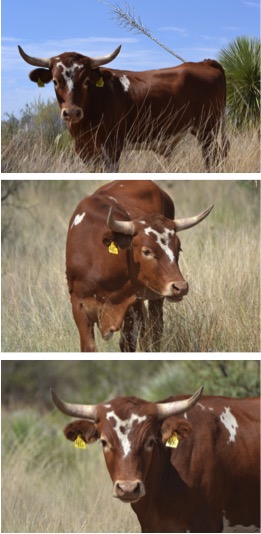|
The Raramuri Criollo’s genetics allow them to thrive in the arid lands of the desert Southwest to a degree that differs from that of common European breeds. Few people know that as well as Dennis Moroney of 47 Ranch in Cochise County, Arizona. Dennis has been ranching with Criollo cattle since the Jornada had enough available for him to purchase six years ago. Now his ranch has over 90 pure Criollo cows and many crossbreds. The Criollo’s smaller frame and diverse browsing behavior allow it to range from low areas to high on top of ridges all within a single day. Their natural extensive movements over landscapes may limit the heavy impact sometimes seen in poorly distributed grazing cattle. One of the more surprising things is how they protect themselves compared to other breeds. “We previously always worked our cattle using cow dogs, and these cattle will go after our cow dogs and run them off,” said Moroney. “It has caused my dogs to keep a greater distance between them and our cattle.” The Criollo do not tolerate perceived predators at all, likely a result of the animals living for hundreds of years in the rural Sierra Madres of Northern Mexico, without the protection of humans. Natural selection has allowed them to learn how to use their horns, which is important on landscapes that are also home to mountain lions, bears, and the newly extended wolf recovery area. Bulls and steers will fight off the predators, and the cows protect their calves. “The other thing I was surprised about them, is that they have a particularly gentle disposition. They’re much calmer cattle than Angus or Brangus. Most of these cattle are from the Copper Canyon region in Mexico. The Tarahumara Indians will catch a cow, tie it to a tree and milk it, and sometimes they are in their front yards of their homes. They’ve evolved a close relationship with human beings.” |
Ranchers like the fact that these animals are very gentle, and can hold their own against predators, but customers love Criollo because of its great taste. Since the introduction of Criollo beef to Arizona markets, customers have had an amazingly positive response. “People will ask for Criollo beef by name and will come back with glowing reports of how much they loved the meat”, said Moroney. These Criollo do not put on a lot of external fat, instead it is interspersed within the muscle tissue, resulting in meat that must be cooked at a lower temperature for a longer time, but is well worth it since it stays incredibly tender. Customers in Arizona can purchase 47 Ranch’s Criollo in Tucson at the Food Conspiracy Co-op, can have it for dinner at any Bianco’s restaurant in Phoenix or Tucson, or can buy it straight from the people who raise it at the Farmer’s Markets in Sierra Vista and Bisbee. Dennis’ favorite thing about the Criollo is how low cost they are to raise. “We are low input ranchers. We don’t provide any supplement, insecticide, wormers, hormones, or antibiotics. They are living out there as wild as the deer.” In fact, the only thing they do provide them are trace mineral salt blocks. They almost never experience sickness and only suffer from the occasional physical injury; these are incredibly hardy and rugged animals that can make it out in the Arizona countryside. Dennis has worked with several European breeds in Arizona, and those have to be supplemented throughout the winter, from Thanksgiving to April, just to achieve a good calf crop. They would have to spend $10,000 - $15,000 per year just on protein supplement for their cattle herd. They haven’t had to buy any supplement since they started raising Criollo. These are trouble-free cattle, and according to Moroney, Criollo are going to be a real game changer for ranchers throughout Arizona, New Mexico, West Texas, Southern California, Chihuahua and Sonora Mexico. Although, since they do range over a broad area, ranchers have to work a little harder gathering them up, but Moroney say that it is well worth it. |




